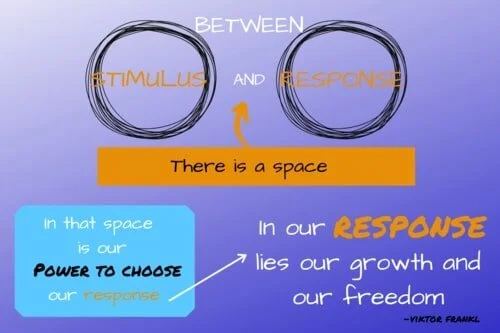Putting a STOPP to the Blow Ups
Helping your ADHD brain regain control when your kids are testing your limits
Last night was a rough one. My husband was at a work event, I had just finished one of my marathon days- 7 clients, 2 supervision sessions and several consult calls, and to top it all off I had just come down with a cold. I was tired, irritable and my kids were mimicking my mood. They were bickering, taunting each other and easily upset.
These days I don’t have that much time with my kids on an average weekday and so I try really hard to put the phone away, ignore the dishes and spend what little time I have with them truly engaging with them on their level. Last night was no exception. As I walked in the door, I put my bag down, took my shoes off and after kissing everyone hello I got on the floor and started playing.
But shortly after I sat down, the niggling, the whinging and the tattling began. The novelty of being at home was enough to sustain my patience for a few minutes but as my cold medicine started to wear off, my head started to pound and my tolerance grew very thin.
Parenting is hard. Our kids have the twin abilities of granting us both greater joy and greater frustration than any other person in the world. So keeping your cool is really tough. But when you have ADHD? The combination of your brain’s tendency to become flooded by emotion as well as its difficulty inhibiting impulses makes the standard struggles of parenting feel impossible at times.
Because of this, parents with ADHD often find themselves being overly harsh or too reactive. Their kids challenging behavior may become more irritating more quickly because of issues with sensory overstimulation and then because the ADHD brain struggles with regulation, it struggles to regulate the frustration that this overstimulation creates. As frustration floods the brain and nervous system it can feel impossible to inhibit the impulse to explode.
But we all know that over-reacting, exploding or yelling not only doesn’t work, it can be damaging to both a child’s relationship with you and their self-esteem. So how do you keep your anger in check?
The most important concept in keeping your cool with ADHD is creating space between stimulus and response. One of the biggest issues with the ADHD brain is that there is little space built in between what happens (stimulus) and what we do (response). For any of us, when we lack space between stimulus and response it means that our actions are almost always rooted in whatever emotion we are experiencing rather than from our thoughts, our desires, our plans, our values or our intentions.
Creating space between what is annoying/ angering/ frustrating or just plain pissing us off- that is the most important step. That gives us time to choose a different way of responding.
When frustration mounts, a good, easy to remember the way to give yourself that space is the STOPP method:
Stop and step back What are the signs in your body that you are getting angry? Does your heart beat faster? Do you get hot and flushed? Does your thinking become clouded? As soon as you notice these signals that is when you want to stop, drop what you are doing and separate yourself from the situation. Last night I put down the legos, got up off the floor and walked into the kitchen out of sight of my boys.
Take a breath. Or 5 or 10, but make them slow and deep. This slows down that physiological process that is brewing in your body that ultimately results in the fight/flight response. If you can slow this system down you can get your brain back on board and make decisions from there instead.
Observe. Take a step back and look at whats going on in your mind and body. Last night, as I walked away, I could feel my heart pounding and a pressure building in my chest. I wanted to yell. I wanted to release that tension and I just wanted the bickering to stop.
Put in Perspective. Think about what is really happening, the larger context and the bigger picture. What advice would you give a friend in this situation? What are your larger goals and values.
Last night, my boys were being 2 and 5- they had had a long afternoon in each other’s company and they were looking for some mom time and vying for my limited, headache-adled attention. My fatigue and headache were really what was making the situation feel unbearable- my boys? They were just being boys.
Practice what works. Whats the next best step? If your friend was in your position, what would you tell them to do after you helped calm them down? What can you do that fits with your goals and your values in this situation?
The answer for me last night was to take a tylenol, give myself a few minutes on my own (glamorous minutes hiding in the pantry) and remind myself the key to my boys good behavior is almost always connection. I was then able to go back into the living room, look both boys in the eye, apologize for my rising frustration and explain about my headache. I then suggested that we try reading a book instead. This is an activity that often feels soothing and connected to my kids when they both feel “high need.”
The STOPP method is a great anger/ frustration/ behavior management for everyone because it slows down the automatic processes at play and allows the thoughtful, value driven self to come back online. For the ADHD brain, though, it sometimes takes a few preparation steps in order to have it be accessible when you need it most.
Identify your red flag sensations
Because the ADHD brain often seems to act before it is even aware that thoughts are possible it helps to identify the cues that those feelings are brewing. These are the flags your body waves at you to tell you it needs some space and attention. So, think back- what was the most recent time that you acted from frustration/ anger/ irritation and responded to your kids in a way you didn’t like?
What was going on in your body? Was your heart starting to race? Did you notice yourself feeling hot or flushed? Did you notice tension rising in your shoulders/ neck or chest? Did you notice yourself feeling hot or flushed? Did you notice tension rising in your shoulders/ neck or chest?
These are your red flag signs. This is your body telling you: BE AWARE, YOUR BRAIN IS GOING OFF LINE AND IM GOING TO TAKE OVER NOW
As soon as you recognize this (and the more you practice it the sooner it will happen) you can separate yourself, calm your body down and start to bring your brain back on line.
Practice in low stakes situations first
The first time you picked up a basketball wasn’t your high school championship game. We need to practice our skills first, before putting them into action where they really matter. So try cueing into your body and your experiences during the non-high intensity situations first. Give yourself space even if you don’t think you are likely to lose it. Think through your values and priorities during low tension moments. Try out the STOPP method at home alone with your kids before trying it at the grocery store/ church/ your in-laws thanksgiving dinner table.
Get your kids in on the STOPP game
Not only is the STOPP method a great tool for kids to use in their own life to help them manage and control their own behavior and impulses. But teaching them about it also serves as an accountability tool for you. Kids have a keen eye for hypocrisy and empty words. My kids love to remind me when Im not following “the rules".” Sure, it can be annoying when they do so but it also has greater impact on me than almost anything else. So teach them the process and make it a team effort.
Create some visual cues
Are you most likely to lose your cool while rushing your kids off to school in the morning? Does dinner time craziness really drive you batty? Is it the bickering in the playroom that gets to you (like it does me?) . Try making some large stop signs and having your kids help you color them in. Then hang them prominently so you are sure to see them. Even if you don’t happen to notice them in the moment, your brain will see them throughout your day and note it. This makes it more accessible when you need it.
As always, practice progress not perfection
You didn’t see the red flags until 10 minutes after you flipped out?
Thats ok- happens to me all the time- look back over what happened, what the red flags were and if there is anything that you could do differently next time. Every blow up, raised voice or empty threat is a learning chance to see what you might be missing and incorporate it next time. It takes time to learn new skills. Be patient with yourself and keep trying. The one thing that is guaranteed to keep you where you are? Deciding your brain just CANT do it/ it doesn’t work for you/ or you will never be able to do it. Keep practicing and learning and be sure to acknowledge the progress you do make.
Ready to shift from
meltdown to mastery?
This online course has been designed specifically to help teach the strategies ADHD brains need to help them move from overwhelm and meltdowns to confident emotional mastery.
Want to know more about
thriving with ADHD?
Check out these other articles:









The best educational apps for kids ages 3-8